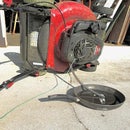Introduction: Better Sound From Echo Dot
Amazon's Echo Dot sounds pretty good for what it is. The Echo is more expensive and includes a tweeter and a resonance chamber. It sounds even better. I wanted to add a quick and easy resonance chamber to the Echo Dot my family gave me about a year ago.
Materials--
- Three 3" black PVC couplings
- Electrical tape
- Plastic covered copper cable (or cotton clothesline rope)
Tools--
- Electric drill
- 1/4" twist drill
- File
- Large countersink bit
Step 1: The Tube
After considering several possibilities, I chose to buy three 3" black PVC couplings. Their internal diameter is slightly larger than the external diameter of the Echo Dot, so it fits inside a coupling. Three couplings cost less than a piece of 3" PVC two feet long. (I did not have any scrap pieces of 3" PVC.) I used black electrical tape to join the couplings. You can see the tape joints in the photo.
An appropriately sized cardboard mailing tube could be used in place of the PVC.
Step 2: Support in the Tube
I had a scrap piece of #6 stranded copper wire. I cut it to length and bent it to fit inside the top coupling. The rib midway down the top coupler keeps it from sliding down. It adds just enough restriction to support the Echo Dot. The Second Photo shows the bent cable in place. The Third Photo shows my Echo Dot resting inside the top coupling.
A piece of cotton clothesline rope could also be cut to length and put in place with hot glue. It all depends on what you have.
Step 3: Hole for the Power Cable
I made a hole in the side of the PVC for the Dot's power cable and tried to make it look as neat as possible. I did not worry about making the hole big enough for the 1/8" stereo mini jack. I figure I will not use it while I am using this resonance chamber.
Step 4: Sound Porting
I drilled about a dozen holes around the bottom edge of the resonance chamber. A twist drill will grab a chip of the PVC and twist your arm around. A much better tool is a large diameter countersink bit. It may be a little slower, but it does not grab and is much safer to use.
Step 5: Ready to Use
My adapted Echo Dot with resonance chamber is larger than an Echo. Its sound is an improvement over the sound of the Echo Dot alone, at the least in my opinion. Adjustment needs to be made for the right amount of resonance. Too much muffles the sound a bit. Play different kinds of music through it. While the music is playing, lift the resonance chamber off of the counter. Do notes in some frequencies sound better? Drill more porting holes above the first set until the sound is as good as it gets and there is no difference in sound between the unit resting on the counter and lifted off of the counter. (Music on my Dot sounded a little muffled. I drilled a second tier of five additional ports holes spaced equally around the tube. The sound is just a bit better now and about as good as I expect it will ever be. It really is quite good.)
This is not perfect and it does not rival more expensive speakers, but it does add a richness to the sound of music from an Echo Dot. If you got an Echo Dot for Christmas and want to optimize its sound when you play music through it, give this a try.











